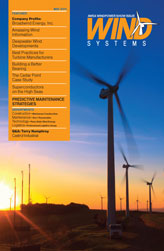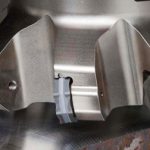At wind farms, maintaining maximum uptime is critical. However, as bearings perform their mission-critical function inside wind turbines, challenges related to dynamic and unpredictable stresses have made this goal difficult to achieve. In particular, the most significant areas of concern are associated with main shaft spherical roller bearings and gearbox spherical and cylindrical roller bearings. Many of these bearings are wearing prematurely, leading to increased turbine maintenance costs, and could lead to sudden, expensive turbine breakdowns. In this article we will look at common main shaft and gearbox bearing reliability concerns, their causes, the impact on performance, and suggested remedies.
Micropitting: Causes and Effects
Spherical roller bearings have been and are being used to support the main shaft primarily because of their ability to accommodate misalignment between the shaft and the bearing housing. If everything works as envisioned with a spherical-based design, it can be an effective arrangement. However, if these bearings experience large amounts of wear, they must be prematurely removed from service.
The most significant wear problem facing main shaft spherical roller bearings is micropitting, a type of surface-initiated fatigue wear. Micropitting is caused by interaction of the raceway and roller asperities, leading to high stresses in the contact. The normal stress alone is not typically sufficient to cause a crack to initiate at or very near the surface early in the lifecycle of a bearing. However, the addition of frictional shear stress increases the bulk contact stress values and brings the maximum values closer to the surface, allowing these localized stresses under the asperity contacts to become significant. This type of interaction typically occurs when the lubricant film is insufficiently thick to separate the contacts and when there is relative sliding between the two contacting surfaces.
Analyses of typical radial and thrust forces on a 230/600 main shaft spherical roller bearing with the radial clearances inherent in the bearing design indicate that the entire load is supported by the downwind row of the bearing, while the upwind row is essentially unloaded. This uneven load distribution results in higher loads on the downwind row, as well as a full 360-degree loaded arc of rollers. The fully loaded arc of rollers increases the number of stress cycles occurring on a point on the inner raceway for every shaft revolution.
Main shaft bearings typically rotate at slow speeds in the 10-20 rpm range, which does not generate a substantial lubricant film thickness even with higher viscosity lubricants. Consequently higher loads, more stress cycles, and thinner lubricant films are present on the downwind row increasing the risk of micropitting, especially if roller/raceway sliding is present.
In bearings, micropitting is a degenerative condition. As it continues more raceway material wears away, causing the loss of profiles in the center and high stress concentrations at the edges of the wear track. High stress concentrations can cause early raceway fatigue, which may result in erosion of the raceway, commonly referred to as “spalling,” and a reduction of the useful life of the bearing. Unfortunately, because micropitting is a wear process, its existence is not always readily apparent. In fact, thousands of hours of operation may be required to generate observable wear on bearings.
To Smear or Not to Smear?
In rolling element bearings, the friction caused by large amounts of roller/raceway sliding can generate local temperatures in the contact zone that are high enough to melt the surfaces of the rollers and raceways, generating a “smeared” appearance on the raceway surface. Sometimes, FeO is found in the smeared region, which means that the local temperature in the contact zone exceeded ~500 degrees Celsius. Smearing is usually a sudden occurrence as opposed to an accumulated wear process, and is known to occur in lightly loaded large bearings and in bearings subjected to high accelerations or rapid speed changes, conditions that are common to wind turbine gearbox bearings.
What is Brittle Flaking?
The phenomenon of micropitting is not exclusive to main shaft bearings. It happens to bearings inside wind turbine gearboxes, too. Gearbox bearings can experience two other problems: the aforementioned smearing, and brittle flaking. Like micropitting, smearing is caused by roller/raceway sliding in thin film lubricant conditions. The origins of brittle flaking are less understood.
Before we examine brittle flaking it should be noted that, due to micropitting and smearing problems in spherical roller bearings fewer, if any, wind turbine gearboxes are being designed and manufactured with this type of bearing. Cylindrical and tapered roller bearings are much more commonly used in newer turbine gearbox designs. Figure 1
So, what causes brittle flaking? Several studies have suggested that the diffusion of hydrogen from the lubricant into the bearing’s steel might be a factor. However, studies that are more recent suggest that large surface shear stresses that cause cracks to initiate at non-metallic inclusions are the more likely cause. The cumulative effect of cyclic shear stresses is believed to nucleate cracks that propagate toward the surface. As the cracks get closer to the surface they reduce the load bearing capability of the steel, and fracturing occurs. Thus, small flakes of steel can become dislodged.
Brittle flaking appears to be more common in cylindrical roller bearings that have a through-hardened Bainetic microstructure. Analysis of bearings that have experienced brittle flaking wear in wind turbine gearboxes indicates that crack initiation frequently occurs at the tiny but numerous sulfide and nitride inclusions in the Bainetic steel rings. To remedy this problem, Timken recommends using case-hardened bearing rings instead of through-hardened Bainetic rings.
How does one address possible gearbox micropitting and smearing? There are at least two options. One potential way is to minimize roller/raceway sliding by using preloaded tapered roller bearings as opposed to cylindrical roller bearings. A second method is to engineer the surfaces of the rollers to reduce or eliminate the consequences of roller sliding in cylindrical bearings. For gearboxes that cannot be adapted to use preloaded tapered roller bearings, surface engineering should be employed to mitigate such micropitting and smearing wear.
Surface Engineering
Surface engineering involves altering the chemical and/or topographical properties of a component’s surface. One surface engineering technique that is being tried in some circles to mitigate micropitting and smearing is the chemical conversion of roller and raceway surfaces from steel to black oxide.
For many years, black oxide has been used on bearings to inhibit corrosion and, in some cases, help break in rollers and raceways that do not have adequate surface finishes. However, black oxide surface treatments wear away rapidly once the bearing is in operation. For this reason, black oxide surface treatments may not provide an effective defense against micropitting. Moreover, several studies have shown that black oxide surface treatments are more prone to smearing damage than nascent steel rollers and raceways. Obviously, a more advanced engineered surface is required for wind turbine bearings to attain their designed lifetimes.
A combination of two engineered surface (ES) technologies—super-finishing and a durable, wear resistant coating applied to rollers—provides extended protection against micropitting and smearing. The super-finishing process produces smooth roller surfaces that decrease the opportunity for roller/raceway asperity contact. Timken’s new diamond-like carbon coating is deposited on top of the super-finished rollers. Like other diamond-like carbon coatings, Timken’s coating consists of nanocrystalline WC precipitates dispersed in an amorphous hydrocarbon matrix. However, unlike these other coatings, Timken’s coating has been specifically designed to endure the high stress cycles of roller bearings. Figure 2
For example, in roller bearings operating at 150 percent of their rated load, Timken’s new coating remains intact on the rollers long after the bearings have exceeded their designed life. While the coating remains intact on the rollers, it reduces then shear stresses between the rollers and the raceway that cause low cycle micropitting and smearing wear. Tapered, cylindrical, and spherical roller bearings that use rollers with these two engineered surfaces are called “wear-resistant bearings.” Rollers in wear-resistant bearings boast several attributes that make them extremely effective at preventing micropitting and smearing.
For one, the coating has a friction coefficient that is about 25 percent that of steel. Therefore, the frictional heating that causes smearing and the shear stress responsible for micropitting are about 75 percent lower than that of untreated rollers. Secondly, since the coating is about twice as hard as the raceway, rollers with this coating dynamically polish the raceway surfaces to roughness values well below those that can be achieved with bearing manufacturing processes. For example, at the conclusion of full-scale bearing testing, the raceways of wear-resistant bearings were measured to be more than 10 times smoother than they were at the beginning of the testing. Finally, once the ultra-smooth raceway finishes are created by the ES-treated rollers, less lubricant film thickness is required to separate fully the surfaces of rollers and the raceways.
Main Shaft Solutions
For main shaft applications, Timken has developed the Timken® Wear-Resistant spherical roller bearings that incorporate the new, durable coating and super-finished surfaces on their rolling elements. These two elements work in tandem to address the root causes of low-cycle micropitting.
In addition to addressing the life-limiting wear of micropitting, the advanced ES treatments on the rollers yield other benefits. The ratio of the lubricant film thickness to the roughness values of the raceway and roller is called the lambda value. Because the super-finished rollers and the highly polished raceways have very small roughness values, the effective lambda value will become much higher than it would be otherwise. The benefits? A higher lambda value can lengthen bearing life and reduce rolling torque losses, resulting in increased efficiency.
Hope for Gearbox Bearings
Wind turbine gearboxes experience load reversals and rapid accelerations and decelerations in daily operation. For several reasons, these transient conditions cause the rollers in cylindrical roller bearings to skid on the raceways, elevating the risk and occurrence of micropitting and smearing.
ES-treated rollers in wear-resistant cylindrical roller bearings significantly reduce the magnitude of the raceway shear stresses from skidding rollers that cause micropitting just as they do in the main shaft spherical roller bearings. Since the ES-treated rollers also reduce the frictional heating from rollers skidding on raceways, wear-resistant cylindrical roller bearings also protect against smearing wear. Recently, tests that were designed to generate the application conditions that produce smearing on wind turbine gearbox cylindrical roller bearings were conducted. Although standard and black oxide-treated cylindrical roller bearings exhibited smearing wear during every test, smearing did not occur in wear-resistant bearings with ES-treated rollers. As long as the coating remains intact on the rollers, smearing wear on raceways will be prevented. Unlike the black oxide surface treatments, Timken’s new coating is designed to be extremely durable on bearing rollers.
Besides addressing the micropitting and smearing problems of gearbox cylindrical bearings, wear-resistant bearings with ES-treated rollers provide several other important benefits to gearbox reliability. Firstly, wear-resistant cylindrical roller bearings operate with significantly less torque during the run-in period and about 15 percent less torque during normal operation compared to bearings with untreated rollers. This provides a measurable increase in the overall efficiency of turbines. Figure 3
Secondly, wear-resistant bearings are exceptionally tolerant to debris damage. Bearings in turbine gearboxes frequently display signs of debris damage, even in gearboxes with well-filtered oil. As ES-treated rollers in wear-resistant bearings polish the raceways, they can also remove the raised edges around debris-generated dents that are responsible for reducing bearing life. Extensive laboratory testing has revealed that the fatigue life of debris-damaged bearings with ES-treated rollers is about two times greater than bearings without treated rollers.
Finally, testing has shown that wear-resistant bearings with ES-treated rollers have about a 3.5 times greater fatigue life than standard bearings under low lambda conditions. Examination of the ES-treated rollers at the conclusion of the tests indicated no visual coating wear.
Total System Approach
Like other complex, highly engineered bearings, wind turbine bearings do not operate in a “vacuum.” Measures can and should be taken to maximize bearing life and performance, even during the bearing installation stage. Unfortunately, it is all too possible to damage or shorten the service life of a bearing before the bearing even becomes operational. Some installation methods like oil baths can increase the chance of bearing contamination. Other methods, such as stationary heating ovens, are cumbersome and can require changes to a facility’s layout.
Heating is another concern. One of the primary causes of bearing failure is overheating. Uneven heating of the bearing can be just as harmful. The solution to these problems is even, controlled heating. Timken offers induction heaters that warm up bearings in an even, balanced manner. This is possible due to the heater’s internal electromagnet, through which a middle frequency alternating current passes.
Keeping bearings correctly lubricated during their lifecycle is important. Knowing how much and how often lubricant should be applied to the critical contact areas of a bearing is crucial. A common practice in two-row main shaft bearings is to provide a single grease injection inlet between two bearing rows. Over time this practice can cause uneven lubrication of each row due to the accumulation of old grease around the grease inlet. Such accumulation forces grease to follow a path of least resistance, which could starve grease to one of the bearing rows.
A better method is to use a low-pressure, centralized lubrication system, such as Timken’s Injector-Based Wind Energy Lubrication System. This system contains a central pump that automatically delivers lubricant through a supply line to multiple banks of injectors. Each injector bank operates independently to lubricate each bearing row. Meanwhile, old grease is pulled to a waste container.
Monitoring bearing conditions after installation is another important piece of the puzzle. Online monitoring systems, such as Timken’s Online Intelligence System, gather data on speeds, temperatures, loads, and vibration. This can alert turbine operators to developing mechanical problems before the loss of power generation occurs. By being mindful of bearing requirements before and during operation, and taking a “total system” approach, wind farm operators can help minimize system damage and preserve valuable uptime.








































